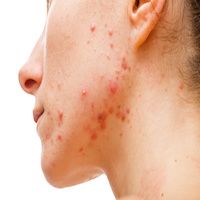Article
Tranexamic Acid Mesotherapy Found to be Effective for Post-Acne Erythema
Author(s):
This study evaluated tranexamic acid injection for post-acne vulgaris erythema, though its smaller sample size may require the findings to be reproduced in large-scale studies.

Tranexamic acid (TA) injection as mesotherapy for post-acne erythema (PAE) may be effective for individuals who have acne vulgaris and consequent PAE, according to new findings.1
This research was authored by Afsaneh Sadeghzadeh Bazargan, MD, from the Department of Dermatology at Rasoul Akram Hospital in Tehran, with the goal of evaluating the efficacy and safety of TA as a mesotherapy.
The investigators also note that the first study to investigate this treatment approach, which is believed to have anti-inflammatory, anti-redness, and anti-angiogenesis properties.2
“To the best of our knowledge, no similar study has examined the usefulness of TA as mesotherapy for post-inflammatory erythema and PAE,” Bazargan and colleagues wrote. “The aim of this study was to evaluate the efficacy and safety of TA as mesotherapy in post-acne erythema.”
Background and Findings
The investigators conducted the clinical trial at a dermatology clinic in the period between September of 2019 to April of 2021, with 17 patients with persistent PAE in total treated with TA as mesotherapy in split-face target regions.
Of these patients, 15 completed the study by the end, as a single participant did not attend follow-up, and another participant discontinued treatment due to intolerance.
The research team included participants who had not experienced an improvement in erythema after 3 months and excluded patients with certain medication interactions, medical conditions, and allergies. Additionally, those who had experienced treatment-related complications or were unable to tolerate the treatment were excluded.
The participants in the study were selected by the primary investigator of the study, and every participant was photographed using a Visioface device before and following treatment. The team noted that 11 were female and 4 of the participants were male, with an age range of 18 – 33 years.
Prior to TA, the participants’ anesthetic cream had been removed from their skin and sterilized using an alcohol swab. Then, TA was injected and depending on the acne erythema severity, they were injected using 2–5 mL of TA.
The right side of each patient's face was treated with intradermal injections of TA, considered the treatment side, while the left side of the face was considered the ‘control arm.’ The investigators had the treatment sessions be performed by a clinician at 2-week intervals, and patients were photographed by the Visioface device before the start of the study and one month following the final TA injection.
The Visioface images were used by the research team to compare both sides of participants’ faces during the treatment period and 1 month following their treatment. The results were then evaluated by the investigators through the use of quantitative scales such as area, lesion count, and area percent.
Overall, the investigators found that participants treated with TA in 2 sessions that were spaced 2 weeks apart showed very strong results, with substantial improvement 4 weeks after starting TA treatment.
The team noted that the average number of lesions on the right side of their faces before and following treatment were 10.9 and 7.1, respectively, while on the left side, they were 9.7 and 8.5. In addition, the mean lesion area (as a percentage of the total area) on the right side before and after the therapy was found to be 1.33% and 0.99%, respectively, and on the left side, it was 1.11% and 0.70%, respectively.
The research team noted that the healing of lesions in number, surface, and area was not found to be substantially connected to the duration of erythema following acne.
“However, due to lack of sufficient evidence, further studies are needed,” they wrote. “Topical TA formulations may also be used in combination with microneedling in future studies to reduce pain and further tolerability.”
Quotes drawn from study edited for clarity.
References
- Bazargan, AS, Ziaeifar, E, Abouie, A, Mirahmadi, S, Taheri, A, Gheisari, M. Evaluating the effect of tranexamic acid as mesotherapy on persistent post-acne erythema: A before and after study. J Cosmet Dermatol. 2023; 00:1- 7. doi:10.1111/jocd.15776.
- Tan AWM, Sen P, Chua SH, Goh BK. Oral tranexamic acid lightens refractory melasma. Australas J Dermatol. 2017;58(3):e105-e108.





